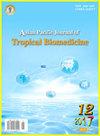Effect of hydroalcoholic leaf extract of Cassia fistula L. on type II collagen-induced arthritis in rats
IF 1.7
4区 医学
Q3 TROPICAL MEDICINE
引用次数: 0
Abstract
Objective: To explore the effect of Cassia fistula on collagen II-induced arthritis in rats. Methods: The effect of 250 and 500 mg/kg chloroform and hydroalcoholic extract of Cassia fistula leaf on collagen II-induced arthritis was investigated by evaluating paw volume, arthritis index, spleen index, and biochemical parameters. Histopathological analysis and docking study were also performed. Results: A dose-dependent reduction in paw volume, arthritic index, and spleen index was observed following oral administration of the chloroform and hydroalcoholic extracts. Treatment with Cassia fistula extracts reduced tumor necrosis factor-α, interleukin (IL)-1β, IL-6, prostaglandin E2, aspartate aminotransferase, alanine aminotransferase, total leucocyte count, and erythrocyte sedimentation rate while increasing IL-10 level. In addition, Cassia fistula extracts improved joint architecture, and prevented cartilage and bone destruction. Docking analysis demonstrated that the physcion, 1-octacosanol, 5,3',4'-trihydroxy-6-methoxy-7-O-α-L-rhamnopyranosyl-(1,2)-O-β-D-galactopyranoside and scopoletin may be responsible for the anti-arthritic effect of Cassia fistula. Conclusions: Cassia fistula suppresses the progression of collagen II-induced arthritis by lowering the inflammatory factors, decreasing paw volume and arthritic index, and alleviating joint architecture. However, further studies are required to confirm the bioactive molecule responsible for the anti-arthritic potential of Cassia fistula.决明子水醇叶提取物对Ⅱ型胶原诱导的大鼠关节炎的影响
目的:探讨决明子瘘对ii型胶原诱导大鼠关节炎的影响。方法:观察250、500 mg/kg氯仿和决明子叶水醇提取物对ii型胶原诱导的关节炎的影响,评价其足体积、关节炎指数、脾脏指数及生化指标。并进行组织病理学分析和对接研究。结果:口服氯仿和水酒精提取物后,观察到足体积、关节炎指数和脾脏指数呈剂量依赖性减少。决明子瘘提取物降低肿瘤坏死因子-α、白细胞介素(IL)-1β、IL-6、前列腺素E2、天冬氨酸转氨酶、丙氨酸转氨酶、白细胞总数和红细胞沉降率,同时升高IL-10水平。此外,决明子瘘提取物改善关节结构,防止软骨和骨破坏。对接分析表明,1-八烷醇、5,3',4'-三羟基-6-甲氧基-7- o -α- l-鼠李糖吡喃基-(1,2)- o -β- d -半乳糖苷和东莨菪碱可能是决明子瘘抗关节炎作用的机制。结论决明子瘘管通过降低炎症因子、减小足部体积和关节炎指数、减轻关节结构,抑制ii型胶原诱导关节炎的进展。然而,需要进一步的研究来证实决明子瘘抗关节炎潜力的生物活性分子。
本文章由计算机程序翻译,如有差异,请以英文原文为准。
求助全文
约1分钟内获得全文
求助全文
来源期刊

Asian Pacific journal of tropical biomedicine
Biochemistry, Genetics and Molecular Biology-Biochemistry, Genetics and Molecular Biology (miscellaneous)
CiteScore
3.10
自引率
11.80%
发文量
2056
审稿时长
4 weeks
期刊介绍:
The journal will cover technical and clinical studies related to health, ethical and social issues in field of biology, bacteriology, biochemistry, biotechnology, cell biology, environmental biology, microbiology, medical microbiology, pharmacology, physiology, pathology, immunology, virology, toxicology, epidemiology, vaccinology, hematology, histopathology, cytology, genetics and tropical agriculture. Articles with clinical interest and implications will be given preference.
 求助内容:
求助内容: 应助结果提醒方式:
应助结果提醒方式:


